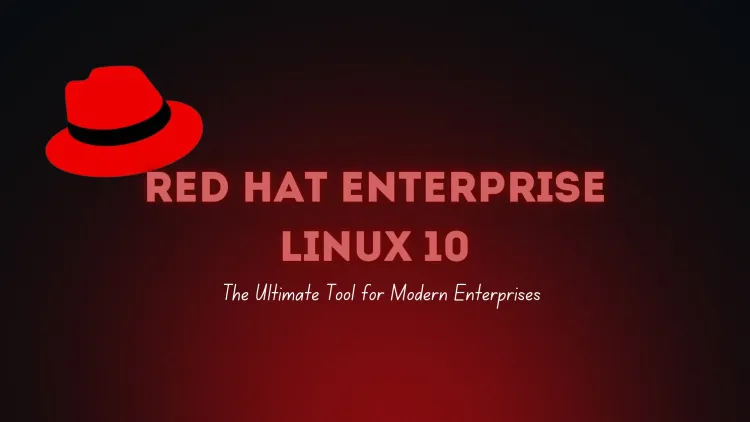Red Hat Enterprise Linux 10 | The Ultimate Tool for Modern Enterprises
Migrating to Red Hat Enterprise Linux (RHEL) 10 offers transformative benefits for businesses. With enhancements in performance, security, and cloud integration, RHEL 10 caters to modern IT needs, enabling organizations to scale efficiently. It supports hybrid cloud workflows, advanced security measures, and developer-friendly tools. Additionally, RHEL 10 offers long-term stability and cost efficiency, making it a reliable choice for future-ready infrastructures.

Migrating to Red Hat Enterprise Linux (RHEL) 10 opens up a world of possibilities for organizations seeking enhanced performance, security, and scalability. As the latest iteration of Red Hat’s enterprise-grade operating system, RHEL 10 is built with the needs of modern businesses in mind. Whether you're running applications in the cloud, managing hybrid infrastructures, or prioritizing security, this version is packed with features designed to streamline operations.
In this blog, we’ll explore the top benefits of migrating to RHEL 10 and why it’s a smart investment for your organization.
1. Enhanced Performance and Scalability
RHEL 10 introduces improvements that allow businesses to handle larger workloads and achieve better performance, whether running on-premises or in the cloud.
Key Benefits:
- Optimized Kernel: A more efficient kernel ensures better memory management and faster processing.
- Modern Hardware Support: RHEL 10 supports the latest processors, storage devices, and networking equipment.
- Container Performance: Enhanced resource allocation makes containerized applications faster and more scalable.
Why It Matters:
With businesses processing massive amounts of data and running resource-intensive applications, RHEL 10 ensures that systems remain responsive, even under heavy workloads.
2. Superior Security Features
Security is a cornerstone of RHEL 10, with advanced features that protect sensitive data and ensure compliance with industry standards.
Key Enhancements:
- SELinux Improvements: Easier configuration and enhanced auditing tools for access control policies.
- Integrated Compliance Tools: Tools like OpenSCAP help maintain security benchmarks such as CIS and NIST standards.
- Updated Cryptography: Stronger encryption with FIPS compliance and support for TLS 1.3 ensures secure communication.
Why It Matters:
In an era of growing cybersecurity threats, RHEL 10 provides businesses with a robust foundation to protect their infrastructure.
3. Seamless Cloud Integration
RHEL 10 is optimized for hybrid and multi-cloud environments, making it easier to manage applications across different platforms.
Cloud-Friendly Features:
- Support for Major Cloud Providers: Native compatibility with AWS, Azure, and Google Cloud Platform.
- Red Hat OpenShift Integration: Effortlessly manage containerized applications with Kubernetes orchestration.
- Cloud-Native Tools: Enhanced tools for monitoring and managing cloud deployments, including Red Hat Insights.
Why It Matters:
With businesses rapidly adopting cloud strategies, RHEL 10 ensures seamless integration and efficient cloud operations.
4. Simplified System Management
RHEL 10 makes it easier than ever for IT administrators to manage servers, automate tasks, and monitor systems.
Key Management Tools:
- Web Console (Cockpit): A browser-based interface simplifies tasks like managing storage, monitoring resources, and troubleshooting.
- System Roles: Predefined configurations for automation of network, storage, and security setups.
- Red Hat Insights: A predictive analytics tool that identifies potential issues before they occur.
Why It Matters:
Simplified management reduces administrative overhead, allowing IT teams to focus on strategic initiatives rather than repetitive tasks.
5. Advanced Developer Tools
RHEL 10 caters to developers by providing modern tools and environments for faster application development.
Developer-Friendly Features:
- Application Streams: Install the latest versions of developer tools without waiting for major updates.
- Programming Language Support: Includes Python 3, Go, Node.js, Java, and more.
- Improved Container Development: Tools like Podman and Buildah make it easier to build and deploy containerized apps.
Why It Matters:
With cutting-edge tools, developers can innovate faster and deploy applications more efficiently.
6. Long-Term Support and Stability
RHEL is known for its enterprise-grade stability, and version 10 is no exception.
Key Benefits:
- 10-Year Lifecycle: Receive updates and support for a full decade, ensuring long-term reliability.
- Enterprise-Grade Quality: Thoroughly tested to ensure compatibility and stability across various environments.
- Support Network: Access to Red Hat’s extensive support team and community for troubleshooting and guidance.
Why It Matters:
RHEL 10’s reliability makes it ideal for mission-critical workloads, where downtime is not an option.
7. Cost Efficiency
Migrating to RHEL 10 can lead to cost savings in the long run through improved efficiency and reduced maintenance needs.
Cost-Saving Features:
- Optimized Resource Utilization: Lower hardware requirements through better performance.
- Reduced Downtime: Proactive tools like Red Hat Insights help prevent costly outages.
- Cloud-Friendly Licensing: Flexible subscription options for cloud and on-premises deployments.
Why It Matters:
By minimizing downtime and maximizing resource efficiency, RHEL 10 helps businesses save both time and money.
8. Future-Proof Technology
RHEL 10 is built with a forward-looking approach, ensuring businesses are ready to adopt emerging technologies.
Innovative Features:
- AI and Machine Learning: Enhanced support for workloads that involve big data analytics and machine learning.
- Quantum-Ready Security: Tools to prepare for advancements in quantum computing.
- Sustainability: Improved energy efficiency for data centers with optimized kernel features.
Why It Matters:
RHEL 10 ensures businesses stay competitive in a rapidly evolving technological landscape.
RHEL 10 vs. Previous Versions
| Feature | RHEL 9 | RHEL 10 |
|---|---|---|
| Kernel Version | 5.x | 6.x |
| Cloud Integration | Basic | Advanced |
| Security Tools | Standard SELinux | Enhanced SELinux, OpenSCAP |
| Application Streams | Limited | Expanded |
| Hardware Support | Good | Optimized for modern devices |
| Performance | Standard | Improved scalability |
Conclusion
Migrating to Red Hat Enterprise Linux (RHEL) 10 offers unparalleled advantages in terms of performance, security, and flexibility. From seamless cloud integration to enhanced system management tools, RHEL 10 is designed to meet the demands of modern IT environments. Whether you’re managing on-premises servers or hybrid cloud infrastructures, RHEL 10 empowers businesses to operate more efficiently and securely.
Now is the time to future-proof your organization with RHEL 10 and unlock the full potential of your IT infrastructure.
FAQ's
-
What makes RHEL 10 different from previous versions?
RHEL 10 introduces a new kernel, enhanced security tools, optimized resource management, improved cloud integration, and better support for modern hardware. -
Is migrating to RHEL 10 a complex process?
While migration may involve some planning, Red Hat offers extensive documentation, support tools, and community resources to simplify the process. -
How does RHEL 10 enhance cloud compatibility?
RHEL 10 supports major cloud platforms like AWS, Azure, and GCP, and integrates seamlessly with OpenShift for managing containerized applications. -
What are Application Streams in RHEL 10?
Application Streams allow developers to access and update the latest software versions without waiting for major RHEL updates. -
How does RHEL 10 improve system performance?
RHEL 10 optimizes the kernel for better memory management, faster processing, and improved resource allocation for containers and workloads. -
Does RHEL 10 provide enhanced security features?
Yes, RHEL 10 includes updates to SELinux, stronger cryptography, compliance tools like OpenSCAP, and FIPS 140-3 certification for encryption standards. -
What tools does RHEL 10 offer for system administrators?
Tools like the Web Console (Cockpit), Red Hat Insights, and expanded system roles simplify management, monitoring, and automation of IT environments. -
What industries benefit the most from RHEL 10?
Industries with critical workloads, such as finance, healthcare, government, and technology, can benefit significantly due to RHEL 10’s focus on security, scalability, and stability. -
Is RHEL 10 suitable for small businesses?
Yes, RHEL 10’s scalability and cost-efficient resource management make it suitable for businesses of all sizes, including small and medium enterprises. -
What kind of support does Red Hat offer for RHEL 10 users?
Red Hat provides a comprehensive support network, including professional services, knowledge bases, and an active community, alongside long-term updates for RHEL 10.














![Top 10 Ethical Hackers in the World [2025]](https://www.webasha.com/blog/uploads/images/202408/image_100x75_66c2f983c207b.webp)








